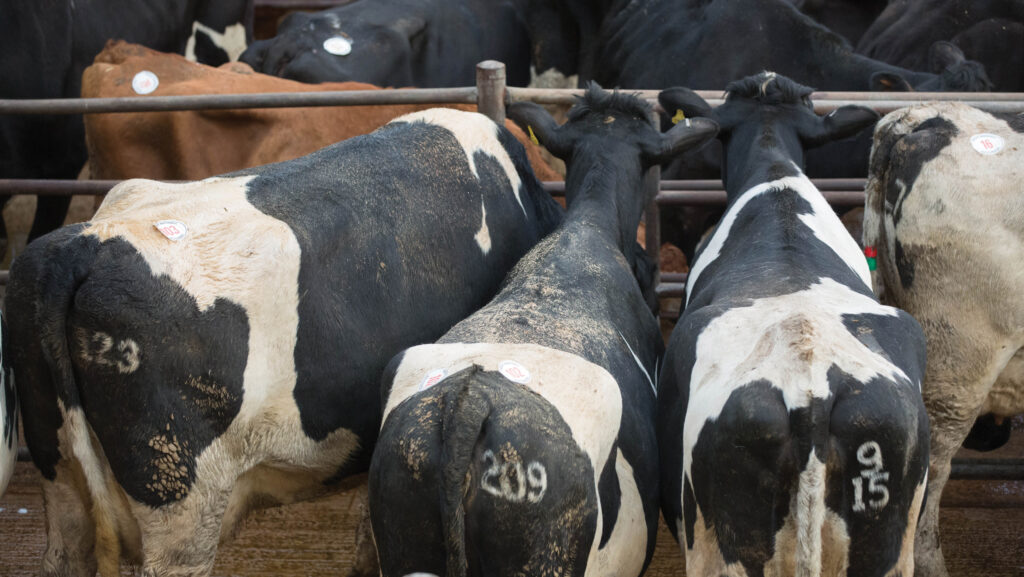Advice on calculating cull cow costs accurately
 © Tim Scrivener
© Tim Scrivener Fluctuating cull cow prices across the year can result in an average cull value for a herd that may be below expectation.
The result can give a false impression of the true cost of maintaining herd size.
The expense of maintaining herd size is the cost of rearing replacements minus the value of culls sold – a figure that is also known as herd depreciation, or herd replacement cost.
See also: Benefits of weighing dairy heifers to improve efficiency
When replacing a mature dairy cow with a heifer, net cull cow value should be considered – not just the most recent good market price, or an average across the year, says LIC consultant Piers Badnell.
Herd lifespan
According to NMR’s 2023 analysis of 500 UK dairy herd KPIs, the average culling rate was 28% and the average number of lactations for a cow exiting the herd was just 3.6.
Yet cows with longer, productive lives allow herd depreciation to be spread over more lactations, which, in turn, lowers replacement rates and costs, says Piers.
Furthermore, extending the productive life of a dairy cow also helps to give a better image to the public about sustainable dairy farming.
Finding ways to reduce culling rates and rear the optimum number of heifers can have a significant impact on farm costs.
Rearing excess heifer replacements is not only expensive, but also increases a farm’s carbon footprint.
Culling cows prematurely means they may not have repaid their rearing costs or achieved mature lactation yields, and this also leads to more heifers being required to fill the spaces.
Analysis of cull records
A useful starting point is to analyse cull records every year, says Piers. He says results should be compared on a three-year and five-year rolling average.
It is important to look at cull cow numbers, reasons for exiting the herd, and how much income they generated:
“Why are cows having to go on the lorry? Why have you got culls and/or casualties? Correct the reason they got there,” he says.
“There is always a reason for a spike in culling rates, so you need to get good information to help make better management decisions.
“Analysing the reasons why cows leave your herd is feedback about your management system and you can then do something about it. It prompts you to improve your system.”
For an accurate cost comparison, Piers says that working out a net cull cow income must consider all cows that have left the farm: dead, or alive (culling for TB is a separate exercise).
As an example, he suggests a 100-cow herd where 20 cows are culled in a year. The farm may sell 17 cows to slaughter, but if three die on-farm, that incurs a £150 a head disposal cost.
Net cull value
“If the remaining 17 cows sell for £600 each, this leads to an income of £10,200.
The average cull value is then thought to be £600, but the three disposals amounting to £450 need to be removed from the cull income.
This results in an actual cull income of £9,750,” he explains.
“Dividing this by the total of 20 cows exiting the herd makes the average net cull value £487.50 a cow. Work it out for your own farm and realise what income you are actually getting.”
Piers says that taking a heifer rearing cost as £1,200 a head, for this 100-cow herd, subtracting the net cull value leaves £712.50 a head as the herd depreciation cost – not £600 as originally thought.
He adds that whatever heifer-rearing cost calculators or formulas are used, breeding costs to generate a heifer calf on the ground must be included to work out the farm’s true replacement cost.
This can range from sexed semen straws to pregnancy diagnosis, and maybe the use of hormone programmes for synchronising oestrus and insemination.
“This might add another £80-90 a head to the original rearing cost,” he points out.
Heifer deaths
Similarly, during the first 24 months of rearing replacements, any calves or heifers that die have still generated costs and these must be shared among the heifers remaining alive.
“For instance, if you have two calves die in 12 months, each one has got a year’s rearing costs behind it, and this increases the actual cost of rearing a heifer to calving.”
Deciding when to cull
Culling decisions tend to be made at housing for summer-grazing herds, either because of lack of space, or to save money on feed, says Piers Badnell.
At grass, he suggests it is better to get rid of culls early and reduce the demand for feed, leaving more for the milking herd.
He also flags the input costs in trying to milk-on cull cows.
“It’s important to ask how much these culls produce in milk and how much you are paying to keep them.
“It will be different every calendar year according to prices and feed availability. Costs may outweigh their milk income.”
He adds that other input costs associated with labour, milking and housing (such as bedding and handling slurry) have to be factored in too, particularly when trying to put weight on dairy culls.
Supply and demand dictate cull cow prices, he points out, so producers should monitor them closely and be ready to sell to gain the best margin.
